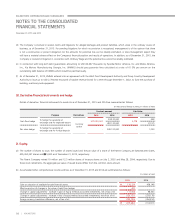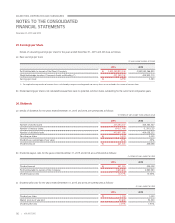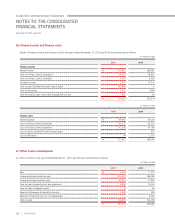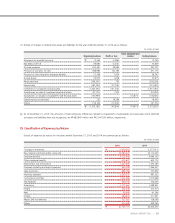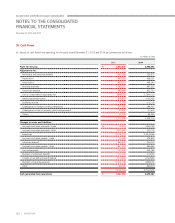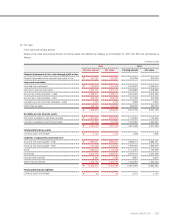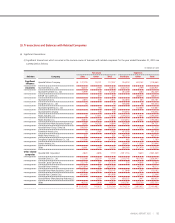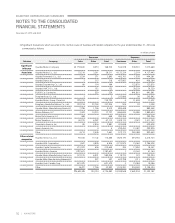Kia 2015 Annual Report Download - page 109
Download and view the complete annual report
Please find page 109 of the 2015 Kia annual report below. You can navigate through the pages in the report by either clicking on the pages listed below, or by using the keyword search tool below to find specific information within the annual report.
(b) Significant non-cash investing and financing activities for the year ended December 31, 2015 and 2014 are as follows:
(In millions of won)
2015 2014
Change in accounts and notes receivable - other in connection to disposal of property, plant and equipment
₩
-(16,218)
Change in accounts and notes payable - other in connection to acquisition of property, plant and equipment 6,377 (45,808)
Change in accounts and notes payable - other in connection to acquisition of intangible assets 26,213 (21,282)
Reclassification from investments in available-for-sale financial assets to associates 205,656 319,830
Transfer from investment in associates to non-current asset held for sale 337,020 -
31. Finance Risk Management
The Company’s activities are exposed to a variety of financial risks: credit risk, liquidity risk and market risk (comprised of foreign exchange risk
and interest rate risk). The treasury department monitors and manages the financial risk arising from the Company’s underlying operations in
accordance with the risk management policies and procedures authorized by the board of directors.
(a) Credit risk
Credit risk is the risk of financial loss to the Company if a customer or counterparty to a financial instrument fails to meet its contractual obligations.
The Company has transacted with customers before evaluating on their credit rating and have their collaterals to control customers on default.
(b) Liquidity risk
Liquidity risk is the risk that the Company will encounter difficulty in meeting the obligations associated with its financial liabilities that are settled
by delivering cash or another financial asset. Management believes the Company maintains adequate sources of liquidity to settle short-term
financial liabilities. In addition, based on periodic analysis of expected cash outflows, the Company also considers other alternatives, including
seeking additional external financing or disposition of financial instruments for investment purpose, to mitigate liquidity risk.
(c) Market risk
Market risk is the risk of fluctuations in fair value of financial instrument and future cash flow by changes of market price. The purpose for
managing market price is to optimize profits, while manage and control on exposure to market risk within acceptable limits.
(i) Foreign exchange risk
The Company is exposed to foreign exchange risk arising from high proportion of export in sales amount, which is denominated in foreign c
urrencies. The Company’s primary exposure is to the US dollar and Euro and the Company manages to minimize financial risk on fluctuations
in foreign exchange in order to stabilize operating activities. The Company consistently evaluates on various foreign exchange risk according to
the Company’s own guideline for foreign exchange and transaction policy. If necessarily, the Company may enter into foreign currency forwards
contracts to hedge its foreign currency risk and strictly limit on speculative transaction.
(ii) Interest rate risk
The Company’s asset and liability is exposed to interest rate risk on deposits and loans. In order to minimize actual Interest cost, the Company
continuously monitors current status of market interest rate, make a prediction on market data and reviews on method for borrowing and
joining financial instruments on deposit. Also, the Company’s management monitors the level of interest rates and maintains the balance of
borrowings at variable rates and fixed rates.
103
ANNUAL REPORT 2015 |



